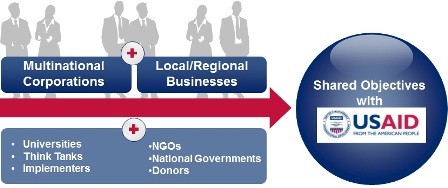- What We Do
- Agriculture and Food Security
- Democracy, Human Rights and Governance
- Economic Growth and Trade
- Education
- Environment and Global Climate Change
- Gender Equality and Women's Empowerment
- Global Health
- Humanitarian Assistance
- Transformation at USAID
- Water and Sanitation
- Working in Crises and Conflict
- U.S. Global Development Lab
Speeches Shim
In an era when 53 of the 100 largest economies in the world are companies and one company alone can reach 4 billion customers —nearly 60% of the global population—working with the private sector is no longer a luxury, but a necessity. In addition, official development assistance (ODA) is no longer the main driving force for international giving. For every dollar of U.S. foreign assistance in 2010, developing countries received an additional $3 in remittances from immigrants living in the United States, $5 in U.S. private capital flows, and $1 in U.S. private philanthropy.
As a result of the changing global landscape, U.S. companies and other private sector organizations are increasingly looking at development as a core strategy issue rather than a matter of corporate philanthropy. However, many of the obstacles that businesses face overseas are really symptoms of the development challenges that USAID is working to address. By working together in partnership, the public and private sectors can find new ways of looking at a problem and develop cost-effective solutions.
Partnering with USAID

The Global Development Alliance program at USAID seeks to advance both U.S. development goals and the private sector’s business interests. By leveraging private sector financial and human capital, expertise, and technologies and innovations; partnerships increase the impact and reach of USAID’s interventions, often resulting in high-impact development solutions that foster sustained impact long after public funding ends.
USAID brings unique assets to its partnerships with the private sector:
- Long-term country presence and extensive relationships with local and national governments;
- Technical expertise across industries and sectors;
- Network of local, regional and global development partners;
- Convening and coordinating power to catalyze, promote and facilitate the development of partnerships;
- Funding; and
- Credibility and goodwill.
As a result, GDAs and other partnerships with USAID have generated a wealth of valuable business and development results, including but not limited to:
- Supply chains in developing countries that now meet international buyers’ standards, foster increased business revenues, and raise incomes for workers and farmers;
- New markets for affordable products that meet the needs of those living in developing countries;
- Skilled workers to support growing telecommunications, health care, and apparel and other manufacturing industries; and
- The use of mobile technology for transmitting information on crops, health issues, etc., thereby connecting local buyers and sellers to international markets and improving health care in poorer communities.
For more information on Doing Business with USAID, check out our Partnering for Impact: USAID and the Private Sector [PDF].

Comment
Make a general inquiry or suggest an improvement.